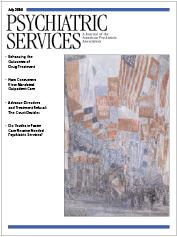Stigma and Public Education About Mental Illness
In Reply: The diversity and depth of opinion represented in the letters by Ms. Arnold, Mr. Stanley, and Mr. Maio about our article reflect the complexity of stigma and its impact on people with mental illness. The variations in their opinions also support an implied goal of our study—namely, that varied assertions about public attitudes need to be tested in empirical research. The goal in our investigation was to collect evidence on how public education about mental illness and violence affects public opinion.
If we understand Mr. Stanley correctly, he seems to assert that stigma may be a regrettable side effect of programs that focus on violence and mental illness—in other words, that increasing fear and avoidance of people with mental illness is necessary to accurately educate the public about mental illness and increase resources for appropriate treatment. It is up to advocates and policy makers to judge the costs and benefits of this kind of policy.
Mr. Stanley also asserts that violence education has a positive effect on resources for mental health services: "Governor Pataki also dedicated an unanticipated $125 million to community services three months after signing the legislation." The connection between violence education and the New York governor's decisions are by no means obvious. Our research showed that the public was not likely to increase resources for mental health care after participating in an educational program that linked mental illness with violence, and actually may have been less likely to support some rehabilitation-based services as a result. Hence, the assertions by D. J. Jaffe (1), Mr. Stanley's colleague at the Treatment Advocacy Center, were not supported in our study: "Laws change for a single reason, in reaction to highly publicized incidences of violence. People care about public safety. I am not saying it is right. I am saying this is the reality."
As policy makers and advocates continue to sift through various opinions about public education and attitudes, they will need more research like this to help them distinguish fact from fiction.
1. Jaffe DJ: Assisted outpatient treatment. Presented at the annual conference of the National Alliance for the Mentally Ill, Chicago, June 30-July 3, 1999Google Scholar



